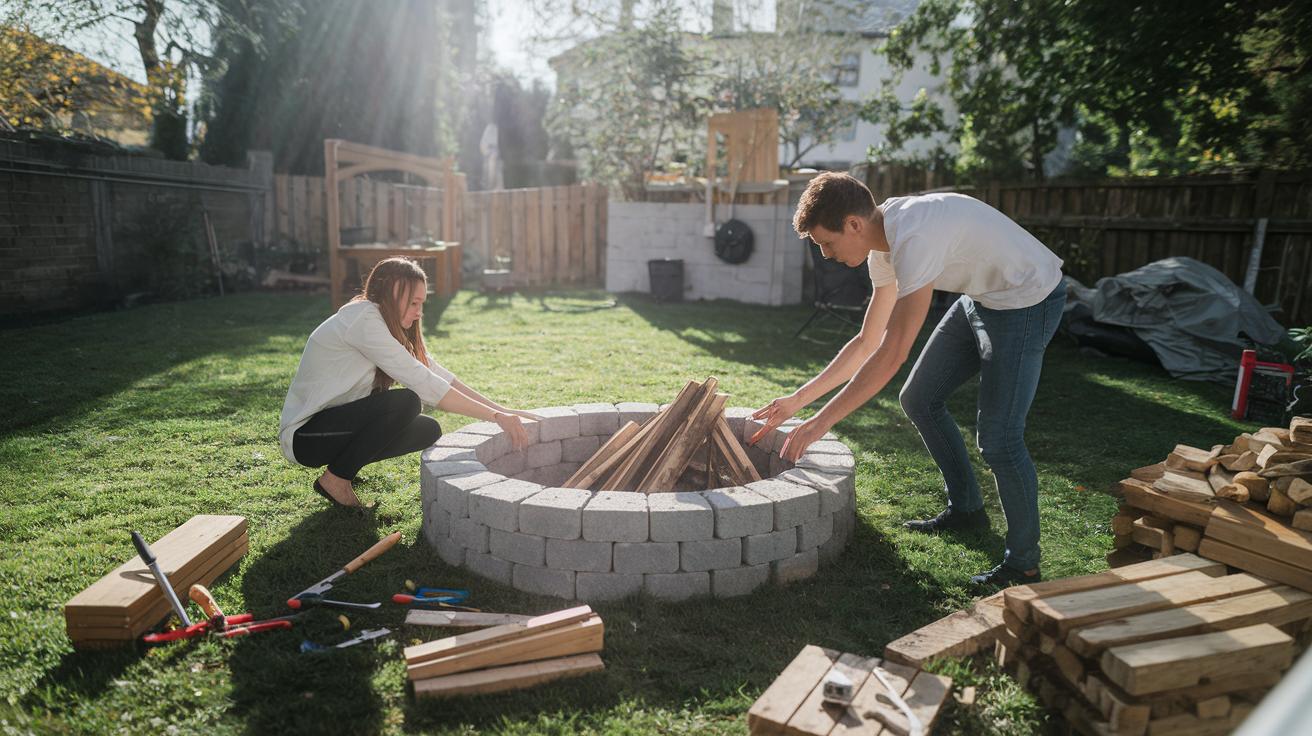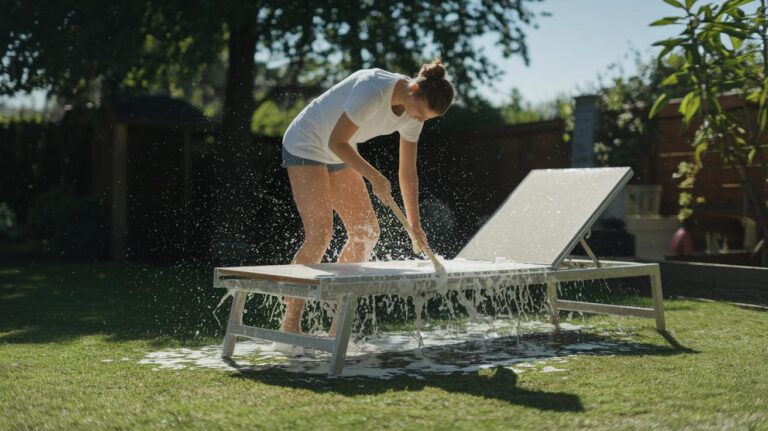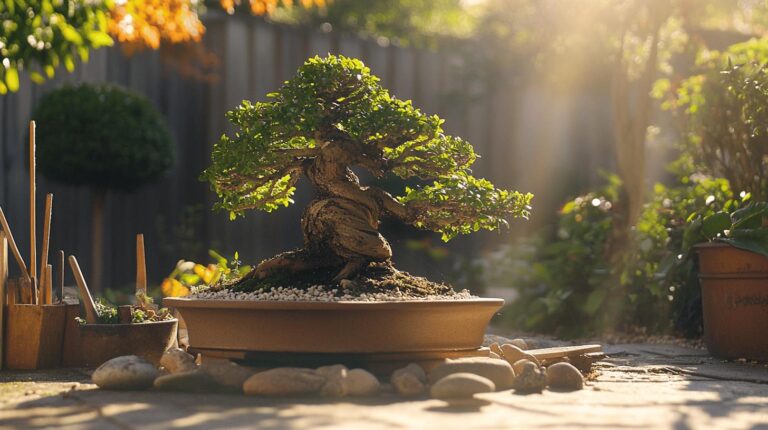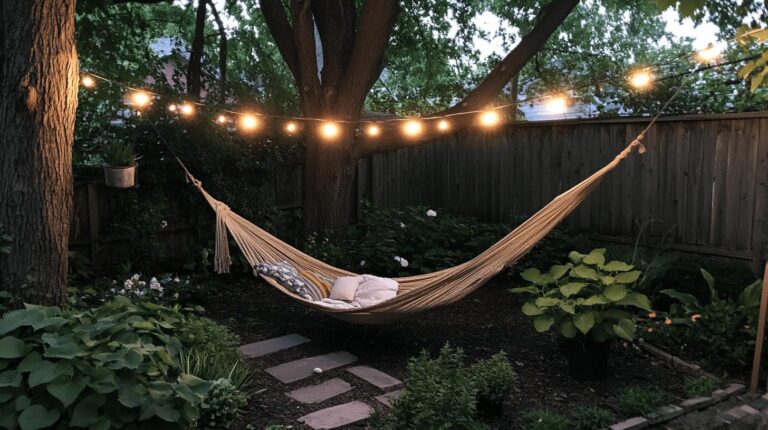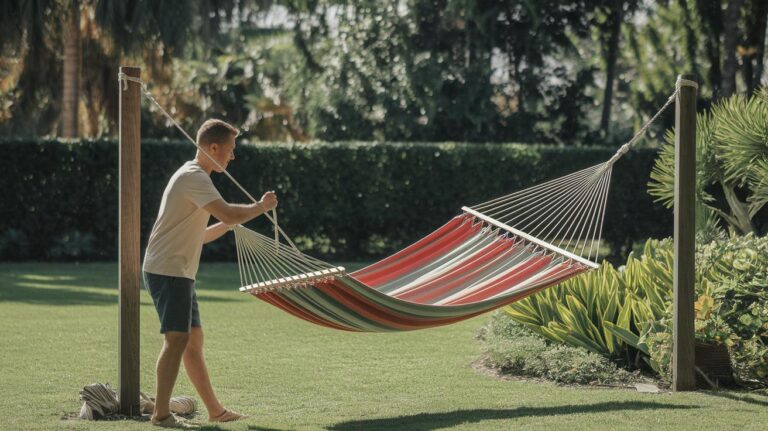How To Build An Outdoor Fire Pit Easily
Think building a backyard fire pit costs a fortune and needs a contractor? Think again. You can finish this project in one weekend with just a few basic tools. Imagine fresh wood smoke drifting through cool evening air as friends settle in for stories and laughter.
First, clear the grass and topsoil (the loose, nutrient-rich upper layer of soil) from a flat spot. By the way, my cat loves to help (I let him think he’s supervising). Back to the steps.
Next, lay about two inches of gravel (small stones) so water can drain away. Then spread a one-inch layer of sand (fine, gritty grains) to level the base. Oops, I meant a one-inch layer of sand… can’t rush it.
Now stack your stones in a circle, building them up until they reach waist height. Leave space inside for the fire ring (a sturdy metal band that keeps the fire contained). Set the ring in place so sparks stay safe and wood burns nicely.
Yes!
By Sunday evening, you’ll be toasting marshmallows around your own crackling fire pit. That warm glow and smoky scent will make your backyard the go-to spot for cozy nights and good company.
One-Weekend Fire Pit Project Overview
So you want a fire pit this weekend? Awesome! You can build a safe, cozy fire pit in a single weekend. Friends and family will gather for warm nights under the stars.
Let’s start by picking the perfect spot. Have you ever smelled wood smoke in the cool evening air?
-
Site prep
Clear grass, weeds, and loose sticks. Mark a 24-inch circle (two feet wide) at least 10 feet from any wall, tree, or fence. -
Foundation build
Dig a 6 to 12 inch hole. Pour in 3 to 4 inches of gravel (small stones that help water drain). Add 2 to 3 inches of sand (fine grains that settle tight) and press it flat with a tamper or the back of a shovel. -
Wall construction
Stack 2 to 4 layers of stones or pavers with outdoor stone glue. Stagger the joints like bricks and tap each layer level with a rubber mallet. By the way, my cat once tried to nap between the stones. -
Final touches
Drop in a fire ring (metal ring that keeps the fire contained). Scatter lava rocks on top. Then line up chairs or logs around the pit, perfect for roasting marshmallows. Oops, I once dropped mine in the sand. -
Safety and compliance
Check local fire codes and clearances. Grab a permit if you need one. Keep tools ready, a shovel, a bucket of water, and a fire extinguisher.
Grab your roasting sticks and lean back. That warm glow is waiting for you.
Step 1: Selecting Your Location
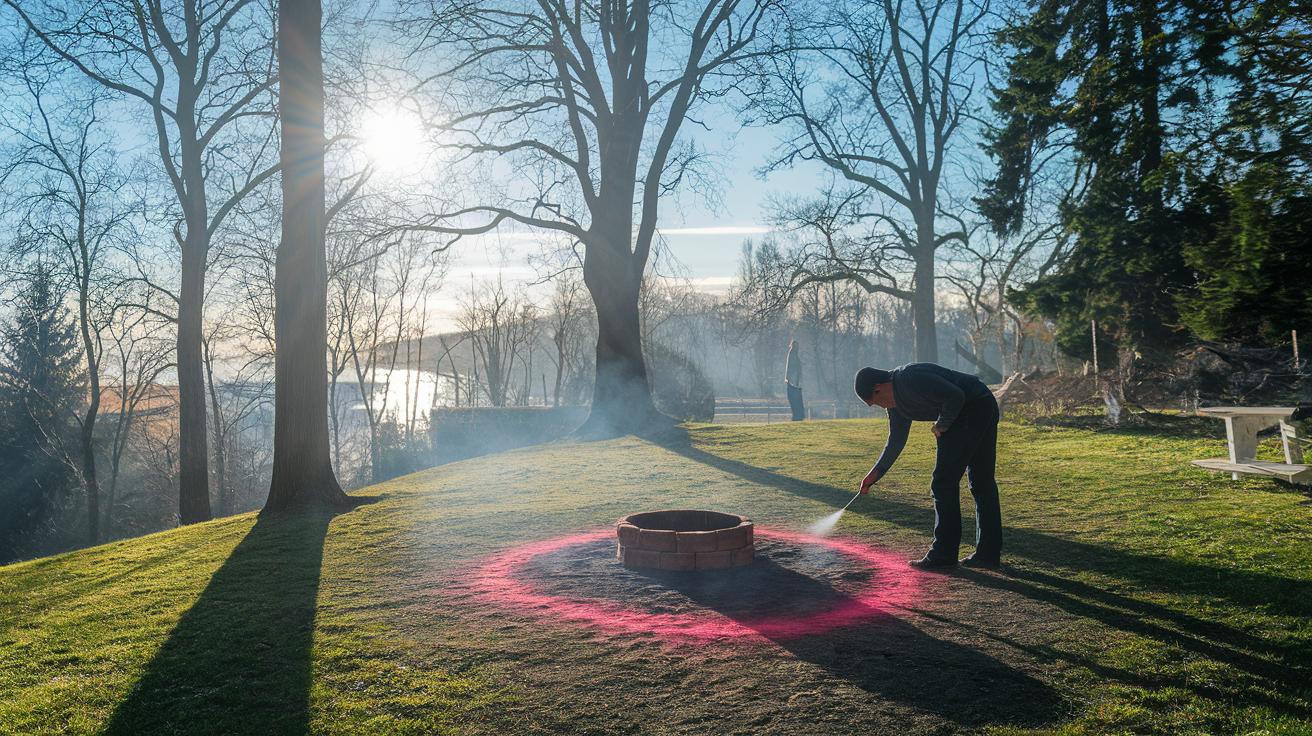
First, scout a spot where the earth feels firm under your boots and tilts just enough to drain water. Pour a little water and watch it disappear. No puddles, please. Aim for at least ten feet from your house, fence, trees, or any low branches.
Next, draw your ring. Hammer a wooden stake in the center, tie garden twine around it, and clip on a stick or use spray paint. Spin the string to sketch a perfect circle. This line shows you exactly where to clear grass, weeds, and debris before digging.
Inside the circle, strip off grass with a shovel (a flat-bladed digging tool) or a mattock (a pick-and-axe tool). Pull out roots, rake up stones, and smooth the soil until it feels soft and even. Oops, sometimes I forget to tighten the twine before swinging, but hey, practice makes perfect.
Outside the circle, clear about two feet of space. This safety buffer will catch any stray embers while you work.
If your ground tilts, level it. Shave high spots or tuck fresh soil under the low ones. Lay a straight board across the circle, drop a small level (the tool that shows flatness) on top, and tweak until it reads level. Then your stones won’t wobble when you stack them.
Call 811 before digging to have underground utility lines marked. It’s the easiest safety step you can take.
Building a Stable Fire Pit Base: Excavation, Leveling, and Drainage
-
Dig the pit
Let your shovel sink into the soil and feel the warm earth crumbling between your fingers as you dig a hole about 6 to 12 inches deep. And if you live where winter bites hard, aim for 18 inches to beat frost heave (when frozen water in the soil swells and lifts). Grab a tamper (a tool that packs soil tight) and press the sides and floor until they stay firm under your shoe. Then pour a cup of water on the base, if it disappears fast, you’re good to go. -
Layer and pack
Spread 3 to 4 inches of gravel (tiny rocks that let water flow) and level it with a rake. You’ll hear the gravel crunch as you smooth it out. Next, shower 2 to 3 inches of sand (soft, fine particles) over the gravel and press it again with the tamper. When the surface barely dips under your hand, you’ve built a rock-solid base.
Stone, Brick, and Paver Fire Pit Wall Construction Techniques
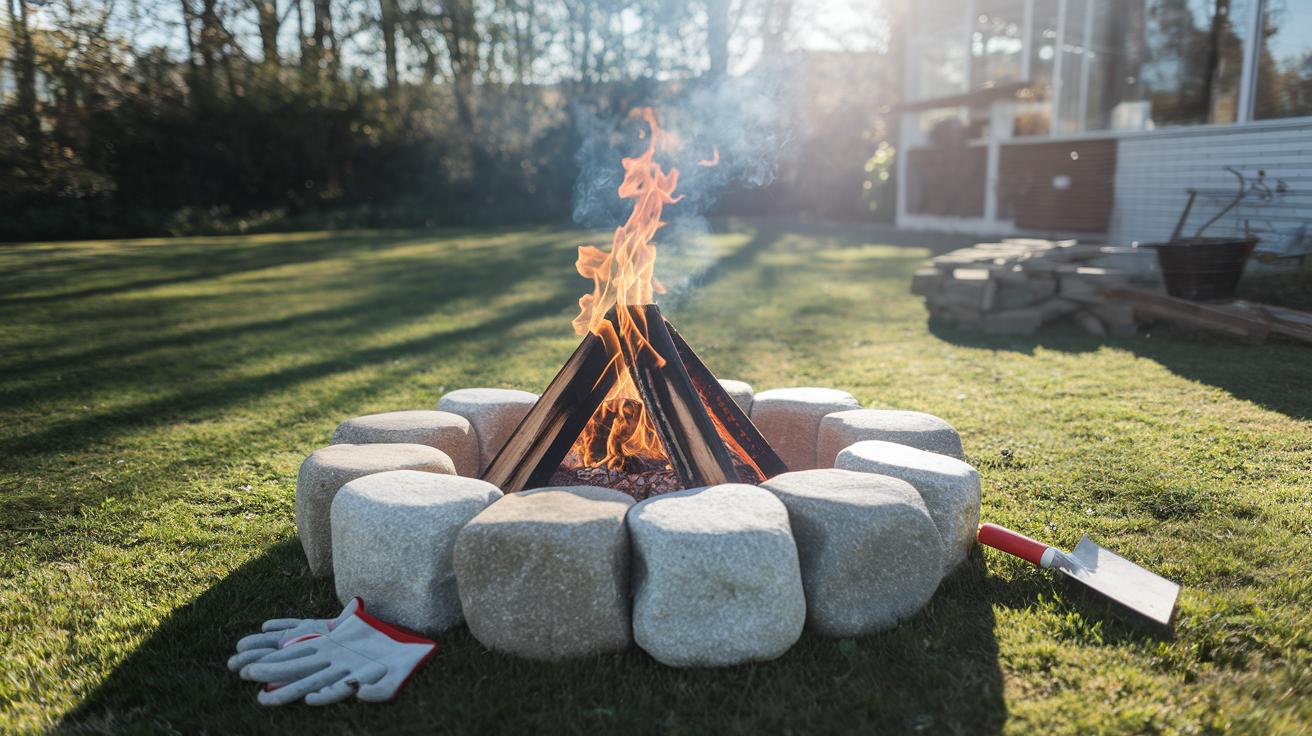
Pick your look first. You might go for rustic natural stone or classic brick. Interlocking pavers work great too in a neat paver fire pit design. For a 24-inch pit, plan on 48 trapezoid pavers (wedge-shaped stones) and 48 mini blocks if you use RumbleStone or basic concrete.
Next, mix your mortar (paste that holds stones) right before stacking. Dump the glue powder into a bucket, add water, stir until it sticks to your trowel without slipping off. Let it rest for the set time on the bag. If it thickens too much, splash in a bit more water and stir again.
Lay your first row on packed sand or gravel (small rocks) so it has a firm base. Press each block into place and give it a gentle tap with a rubber mallet until it feels solid. Run a level across opposite stones to check for flatness. It’s a bit like tuning a guitar – small tweaks until everything sits just right.
And here’s the trick: put a thin bead of masonry adhesive (strong glue for blocks) along the top of that first row. Then stagger your second row so the seams never line up with the ones below. Staggered joints lock the wall together and keep it from leaning. You can build up to four rows, checking your level each time.
If you want a smooth ledge for drinks or marshmallow sticks, add coping stones (wide, flat caps) on top. Spread a thin blanket of adhesive under each stone, then tap them down so they settle snugly. By the way, my cat loves curling up on coping stones when they warm in the sun. This simple step gives your pit a friendly finish.
Take your time. Working too fast can leave lumps of glue or wobbly rows. Every tap of the mallet should give you a solid thunk. Step back now and then – maybe under your camp lantern light – to make sure the wall stands straight before you light that first fire.
Installing the Fire Pit Ring, Burner, and Fuel Options
If you’re making a wood fire pit, slide a steel ring into your stacked stones. This metal insert keeps logs centered and shields the stones from scorching heat. And it works without any gas line or plumbing fuss. You’ll love the crackle and smoky scent drifting on a cool night, you know.
For a natural gas fire pit, pick the Crossfire 30" brass burner (the metal part that makes the flame) for big heat, it pumps out 180,000 BTUs (heat energy). Rest it on a 3" bed of sand so the warmth spreads evenly. Hire a licensed plumber to tap your existing gas line, bury the pipe underground, and handle all the local code steps. Then you get steady fuel and easy quarter-turn control for perfect flame height.
Light the burner with a long match or lighter. Turn the knob a quarter turn and watch the flames leap up. A small twist dials them back down to a cozy flicker. Scatter 2" of small lava rocks (porous stones) around the burner, then drop larger stones on top so flames peek through, never use river rocks, they trap water and might pop or crack.
For a propane setup, swap the stub for a propane cylinder using a rated regulator (pressure device) and hose kit. Clip the hose on, tighten the clamps, and do a soapy water test to catch any leaks. Always turn off the main valve when you’re done. And keep a fire extinguisher or a water bucket close by, just in case sparks wander.
Fire Pit Seating, Accessories, and Aesthetic Enhancements
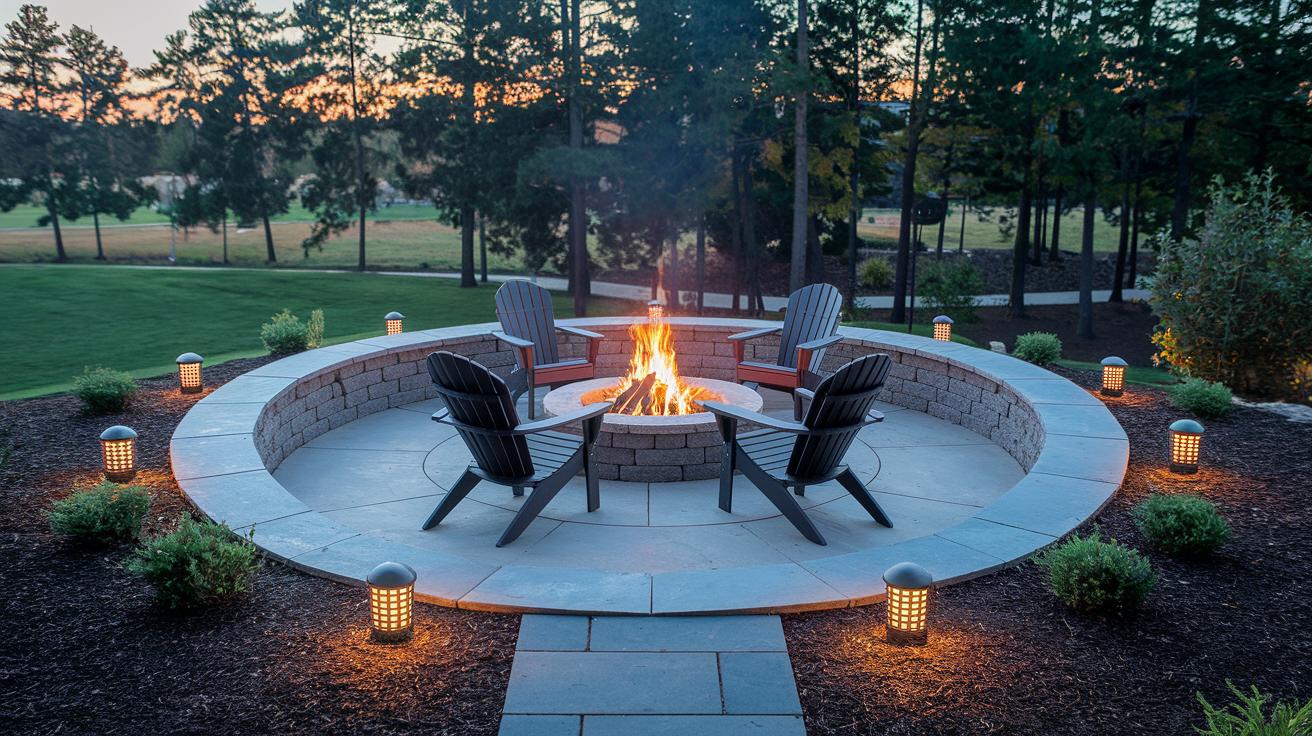
Grab two Adirondack chairs and pull them close so you can feel the warmth of the crackling flames. Or build a curved bench from wood or stone that wraps around the fire’s glow. Check out these patio seating ideas for more inspiration.
Lay a crushed limestone (tiny broken rock) pathway leading to your pit. Tuck landscape fabric (a cloth that blocks weeds) under the edges. Then secure edging (a wood or metal strip) to keep gravel and chairs from shifting.
Here’s a simple checklist to finish your fire pit zone:
- Spark screens (mesh cover that keeps embers in)
- Steel covers (metal lid that shields from rain)
- Cooking grates (fold-up grill for hot dogs and veggies)
- Poker tools and tongs (long handles to move logs safely)
Add soft lighting to set the mood. Stake solar path lights along your limestone trail so there’s a gentle glow underfoot. Place citronella torches in corners for that lemony scent that sends bugs packing. A small side table makes a perfect spot for mugs and marshmallow skewers.
Plant stories, s’mores, and starry nights right here in your backyard.
Fire Pit Safety, Compliance, and Maintenance
Before you light another fire, swing by city hall or ring up the fire department to check local fire codes and any permit rules. Keep a ten-foot circle around the pit clear of chairs, logs, or tools. I like to lay out a ring of stones so everyone spots the safe boundary.
Have you ever felt the soft heat ripple off glowing coals? Once the flames die down and the ashes feel cool to the touch, scoop out the gray ash every two or three fires with a small shovel. Ash piles trap dampness and make your next fire slow to catch and smoky. I once skipped this step and spent the evening breathing gray puffs.
Each year, grab a wire brush and scrub soot and loose bits from the brick or stone. Then paint on a water-resistant sealant (it keeps rain out) with a brush. Let it bake in the sun until water beads on top. This little move stops stones from cracking and wearing out.
When rain clouds roll in, pull a weatherproof vinyl cover over the pit. In cold months, slide a tarp under it to block snow and ice. Oops, I forgot once and my lava rocks sat soggy until spring.
Every few months, check mortar joints or block edges for cracks or gaps. Fill holes with patching mortar or stone filler. Then wait the time listed on the bag before lighting up again. A solid wall holds in the fire’s heat safely.
Cost and Time Estimates for DIY Outdoor Fire Pit Projects
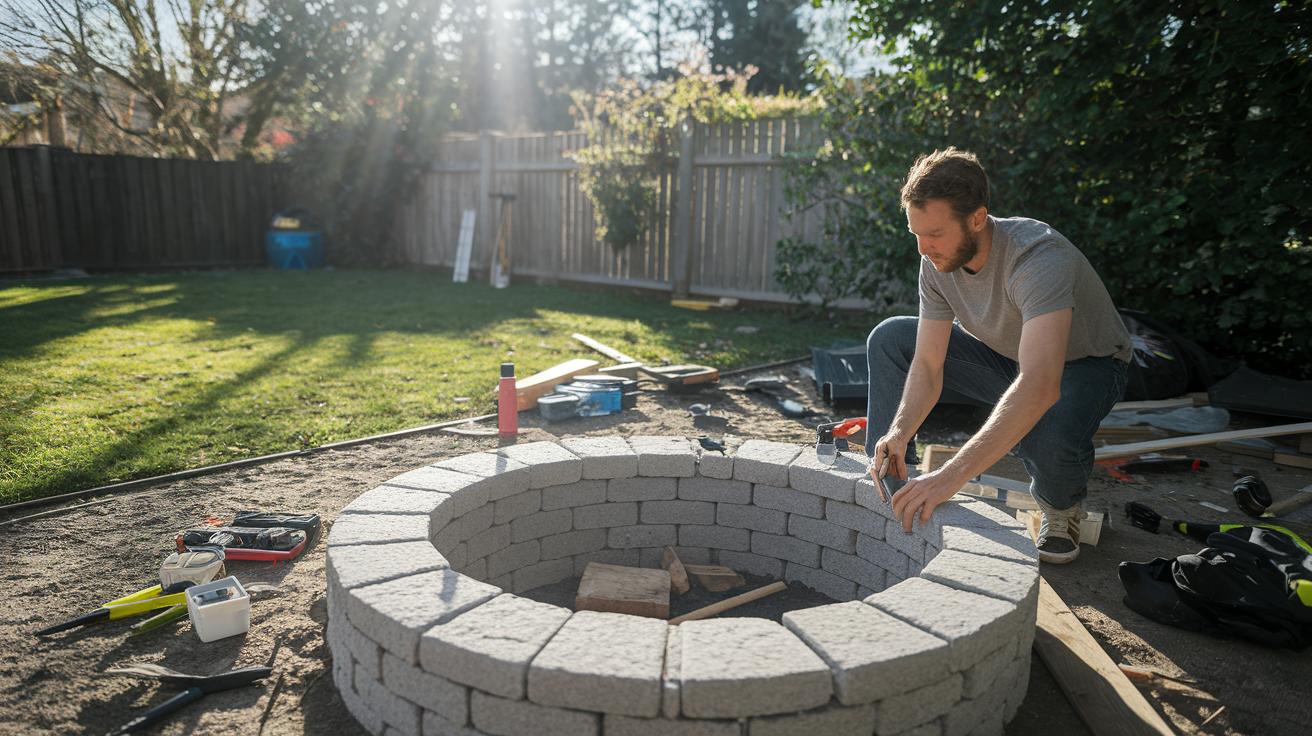
Building your own stone or block fire pit usually costs about $200 – $600 for stuff like pavers (flat stones for walkways), gravel (small stones), sand, and strong glue. Picture the cool stones in your hands and that smell of fresh dirt – it’s a fun start.
If you choose a premade kit, you’re looking at $500 – $1,500 depending on its size and finish. Hiring a pro will push your total past $2,000 once you add labor and permit fees.
Most people wrap up in one or two weekend days. Plan for moderate digging – maybe a full day if your soil is hard or full of roots. Renting a tamper (tool for packing soil), level (tool to check flat), or mixer (machine for mixing materials) can add $50 – $100. If digging drags on, ask a friend to chip in or split it across two short days. Oops, I once forgot my gloves in the middle of the work.
| Option | Cost | Time |
|---|---|---|
| DIY stone or block build | $200 – $600 | 1 – 2 weekends |
| Premade fire pit kit | $500 – $1,500 | 1 weekend |
| Contractor install | $2,000+ | Depends on crew |
That warm glow and crackle of wood will feel amazing. Now you know the costs and time so you can choose whether to roll up your sleeves or hire some help.
Final Words
We jumped straight into site prep: marking, digging, and leveling so your backyard’s ready. Then we built a sturdy base with gravel and sand, stacked stones carefully, and secured a ring or gas burner.
Next came seating ideas, benches, Adirondacks, and must-have accessories like spark screens and path lights. Finally, we covered safety checks, local codes, and cost/time estimates to keep surprises at bay.
With this guide on how to build an outdoor fire pit, you’re all set to spark up cozy nights.
FAQ
How can I build an outdoor fire pit on a budget?
Building an outdoor fire pit on a budget means choosing affordable materials like reclaimed bricks, river rock, or a steel drum, using gravel for the base, and stacking stones without professional mortar.
What are small backyard fire pit landscaping ideas?
Small backyards shine with a compact stone or metal ring on a gravel or paver pad, low-profile seating walls or Adirondack chairs, solar path lights, and vertical planters to save ground space.
How do I build an in-ground fire pit?
Building an in-ground fire pit involves digging a 6–18” hole, tamping a 3–4” gravel layer, adding 2–3” of sand, leveling, then lining with a metal ring or stacked stones for structure and drainage.
What materials can I use for DIY fire pit walls?
DIY fire pit walls can use stacked stones, interlocking bricks, pavers, or a repurposed steel ring. Stack two to four levels, stagger each course for strength, and apply masonry adhesive if you skip mortar.
What do you put in the bottom of a fire pit?
You put a 3–4” layer of crushed gravel at the fire pit bottom for drainage, topped by 2–3” of sand to level the base and protect the ring or stones from moisture and frost.
Is it cheaper to build or buy a fire pit?
It is cheaper to build your own fire pit, with DIY materials costing around $200–$600. Premade kits range $500–$1,500, while professional installation often exceeds $2,000.

